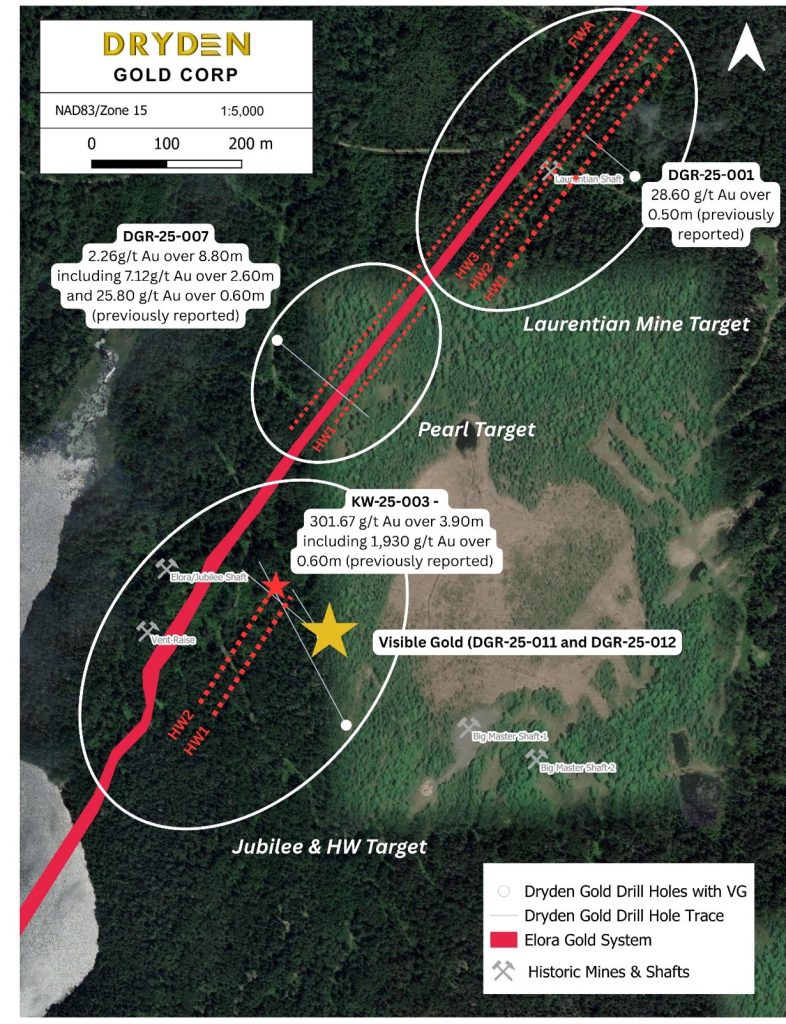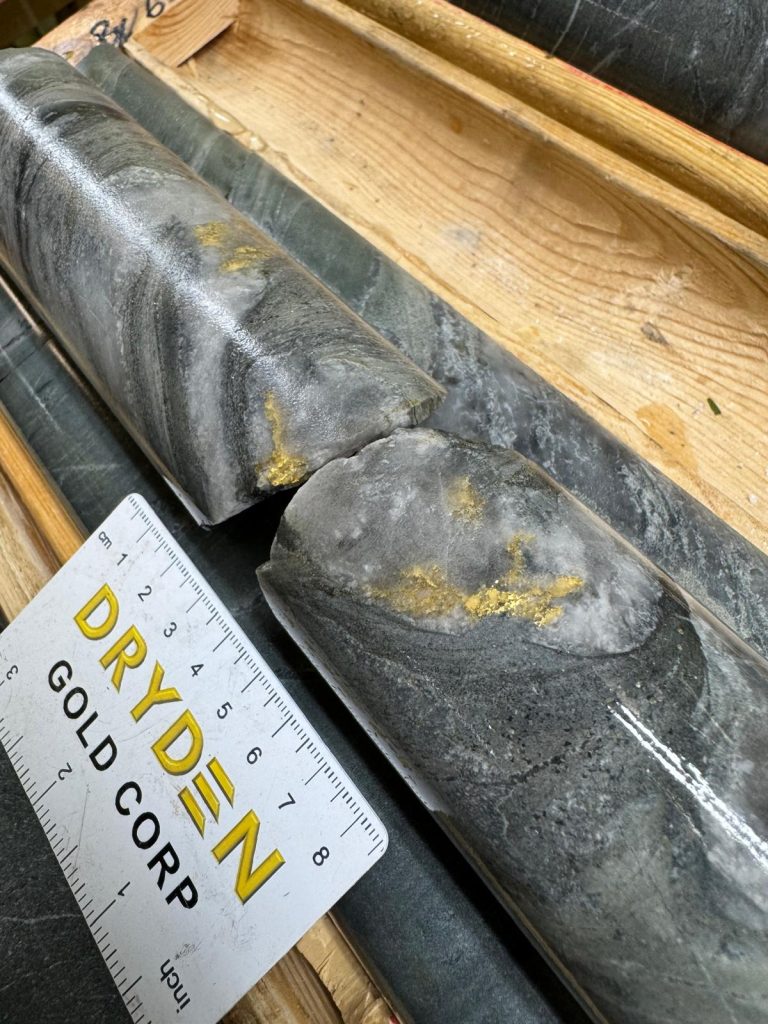2025 Drill Program Objectives
- Grow the Elora Gold System on strike testing new structural intersections
- Expand high-grade mineralization down plunge at the Jubilee Zone at Gold Rock
- Test new targets along strike at Gold Rock
- Investigate highly prospective regional targets
Plan Map of Reported Drill Holes

2025 Exploration Strategy Video
Structural Story at Gold Rock
New Mineralized Structure Showing Significant Visible Gold at Elora Gold System (April 8, 2025 News release)






Visible Gold from Laurentian Mine Target Hole DGR-25-001 New Hanging Wall Zone (May 27, 2025 News Release)

Visible Gold from Hole DGR-25-007 at the Pearl Target (May 27, 2025 news Release)

Visible Gold from holes DGR-25-011 and DGR-25-012 at Jubilee Target (June 24, 2025 News Release)


- Hole KW-25-003 indicates a new zone of hanging wall (parallel)
- New zone ~80 meters from main Elora zone
- Untested Targets Northeast along strike
- Additional parallel mineralized zone on the Big Master Gold System
- Recent results on Pearl and Laurentian have confirmed the importance of the intersecting deformation events and these stacked structures as the exploration potential at Gold Rock continues.
Jubilee & pearl Targets Contoured long section

Hanging Wall Long Section at Elora gold system

- Based on the geophysical data interpretation and geological mapping done to date, the Pearl Target is based on the intersections of the three structural trends.
- There are a few historical drill holes near the Pearl Target that show prospective mineralization.
2024 Drill Program Overview (Phases 1-6)
phase 6 drill program
Highlights Include:
- Hole KW-24-026 intercepted the mineralized zone at approximately 190 meters from surface and returned 5.92 g/t gold over 12.34 meters, including 19.43 g/t gold over 1.74 meters and 42.40 g/t gold over 0.50 meters.
- Hole KW-24-028 was drilled 60 meters northeast along strike at hole KW-24-026 and returned 3.88 g/t gold over 13.81 meters, including 12.51 g/t gold over 3.50 meters and 10.60 g/t over 0.51 meters.
- KW-24-029 was drilled 90 meters northeast along strike of hole KW-24-026 intercepting 4.17 g/t gold over 5.75 meters, including 17.30 g/t gold over 1.18 meters.
- Hole KW-24-027 was drilled 20 meters deeper than KW-24-026 and intercepted 0.91 g/t gold over 16.55 meters.

Phase 5 Drill Program
Highlights include:
- Hole KW-24-017 intercepted 30.72 g/t gold over 5.70 meters, including its highest-ever intercept of 313.00 g/t over 0.55 meters (Table 1).
- Hole KW-24-024 intercepted 8.93 g/t gold over 12.45 meters, including 32.96 g/t gold over 2.73 meters at Elora. in addition, this hole intercepted a hanging wall structure that returned 1.67 g/t gold over 2.75 meters, including 8.41 g/t gold over 0.43 meters.
- Phase 5 drilling has been completed. Remaining drill results are expected in the coming weeks. This phase consisted of nine holes totaling 1,598 meters focused on the depth expansion at Elora and Big Master 1 gold systems and infill drilling at Big Master 2.
- Video summaries of our released drill holes can be found here.


Elora Gold Structure:
- Four holes have been completed to test the extension of the Elora gold system along the high-grade plunge.
- Hole KW-24-008 reported earlier this year returned multiple intercepts of both quartz veining and sulphide mineralization returning 14.10 g/t gold over 7.54 meters including 43.81 g/t gold over 1.42 meters and 92.10 g/t gold over 0.30 meters.
- Hole KW-24-017 reported here, intersected mineralization 30 meters deeper and 45 meters along strike of hole KW-24-008 (Figure 1).
- The zone intersected in hole KW-24-017 is located at 220 meters true depth and consisted of pyrite mineralization and quartz veins within sheared volcanics. Adjacent to the mineralization zone a felsic dyke was observed which is hypothesized to be a correlated to the gold bearing event and was observed in the majority of the high-grade holes in the Gold Rock Camp.
- Two additional holes (KW-24-024 and KW-24-025) were drilled as part of the Phase 5 program focused on the plunge extension of hole KW-24-017 with assays pending


Phase 4 Drill Program
Highlights include:
- KW-24-013 assays 0.74 g/t gold over 10.50 meters
- For a video summary of drill results, please click here
Phase 3 Drill Program
The program can be defined with three specific objectives:
- Evaluate high-grade controls on the Elora system
- Complete extensional holes from the known mineralization
- Test larger step-out holes along strike of the Elora gold system
Highlights include:
- KW-24-008 intercepted 14.10 g/t gold over 7.54 meters, including 43.81 g/t gold over 1.42 meters and 92.10 g/t gold over 0.30 meters.
- KW-24-003 intercepted 53.51 g/t gold over 1.05 meters, including 181.00 g/t gold over 0.30 meters.
- For a video summary of drill results, please click here.
Phase 1 & 2 Drill Program
- Successfully interested new high-grade shoot on BM1
- KW-23-009A intersecting 26.11 g/t gold over 3.16 m, including 79.80 g/t gold over 0.33 m
- Confirmed 1.5 km strike length on the Big Master gold system – open in all directions
- Significant step-out to the northeast of 450 m KW-23-004 returning 3.40 g/t gold over 1.60 m
- KW-23-010 intersecting 3.70 g/t gold over 6.00 m, including 10.60 g/t gold over 0.4 m
- Confirmed orientation and expanded historically delineated high-grade shoot
- KW-23-016 which intersected 3.81 g/t gold over 7.00 m, including 71.00 g/t gold over 0.30 m
- KW-23-018 intersecting 6.66 g/t gold over 4.30 m, including 44.80 g/t gold over 0.27 m

- Several holes were focused on testing the controls on high-grade shoot orientation caused by intersection of structures (lineation) and fold hinge orientation.
- Previous drilling indicated the potential for these new high-grade shoots, but the continuity and orientation of the potential shoots had not been previously tested.
3 New High-Grade Shoots Identified:
- KW-23-009A returned 26.11 g/t gold over 3.16 m, including 79.80 g/t gold over 0.33 m BM1
- KW-23-010 intersected 3.70 g/t gold over 6.0 m including 10.60 g/t gold over 0.40 m BM2
- KW-23-016 returned 3.81 g/t gold over 7.00 m, including 71.00 g/t gold over 0.30 m


Near Surface High-grade Gold Across the Property
Gold Rock Camp Drill Highlights
- 30.72 g/t gold over 5.70 meters
- 15.17 g/t gold over 6.95 meters
- 15.4 g/t gold over 6.1 meters
- 26.11 g/t gold over 3.16 meters, including 79.80 g/t gold over 0.33 meters
- 6.66 g/t gold over 4.30 meters, including 44.80 g/t gold over 0.27 meters
- 3.81 g/t gold over 7.00 meters, including 71.00 g/t gold over 0.30 meters
- 53.51 g/t gold over 1.05 meters, including 181.00 g/t gold over 0.30 meters
- 3,497.0 g/t gold over 8.5 meters *historic hole* including 53,700 g/t gold over 0.55 meters
Hyndman Field Samples
- 34.8 g/t gold grab sample 2024
- 13.0 g/t gold grab sample 2023
- 12.3 g/t gold grab sample 2023
- 10.9 g/t gold grab sample 2023
- 6.41 g/t gold grab sample 2024
Sherridon Drill Highlights
- 7.7 g/t gold over 3.0 meters *historic hole*, including 46.0 g/t gold over 0.5 meters
- 15.4 g/t gold over 5.5 meters *historic hole*, including 83.1 g/t gold over 1.0 meters
Sherridon Field Samples
- 617.0 g/t gold grab sample (historic)
- 184.5 g/t gold grab sample (historic)
- 123.0 g/t gold grab sample (historic)
- 122.5 g/t gold grab sample (historic)
Geophysics

Geophysical Interpretation & Targets
- The geophysical interpretation highlighted many anomalies over known mineralization and over unexplored areas
- 3D geological model shows multiple East-West splay structures occurring around historic gold mines & occurrences in the Gold Rock Camp
- Geophysical anomalies occur over known mineralized zones
- Geophysical targets indicated potential for 20km strike along the MDdz in the Gold Rock Camp
Bulk Sample Highlights
Excellent Bulk Sample Results & Metallurgy
- Single gravity separation recovered 88.6%
- Bulk cyanidation test recovered 99.4% for the composite
- A total of 17 chip samples, over 13.6 linear meters yielded a length weighted average grade of 40.2 g/t gold
- Individual chip samples ranged from 0.05 to 1,070 g/t gold drill cuttings samples over a 30-metre section of the vein yielded an average grade of 5.4 g/t gold.
- Individual drill cuttings yielded grades ranging from 0.02 to 65.1 g/t gold

Gold Concentration in “Crackseal” Fractures
Gold is concentrated in the “crackseal” fractures and in selvedges along the quartz vein margins. Calcite filled fractures within quartz veins also carry gold. Narrow gold-bearing semi-massive sulphide filled fractures within fissile zones also contain significant gold values. Pervasive ferroan carbonate alteration, disseminated sulphides, and very small barren quartz veinlets characterize the fissile zones.
Sulphides are predominantly pyrite, with variable amounts of chalcopyrite. The gold tenor appears to be related to the quantity of pyrite present in the wall rock and in veins.











Geology Gold Rock Camp
Area 1

Historic Hole: 53,700 g/t gold over 0.55 meters

Geology Gold Rock Camp
Area 2

Geology Gold Rock Camp Area 3 | Similar Geological Setting to Red Lake Mine

Gold Rock Regional Exploration

Dryden Gold’s Resource Pipeline

Elora Gold System | Jubilee Zone Expanding Strike & Depth

Gold Rock Target Area

Geophysical Interpretation & Targets

Visible Vein Where Bulk Samples Were Taken


